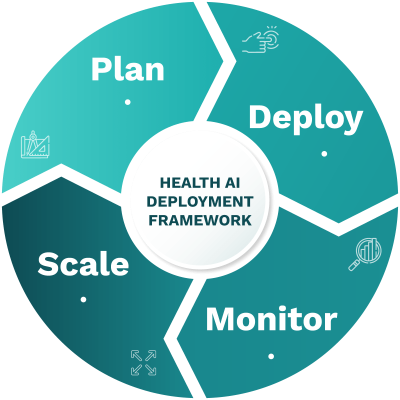DIME PROJECT

Implementing AI in Healthcare
Implement and scale AI across your system
![]()
This is where AI transitions from promise to practice. It’s where governance is activated, infrastructure is built, and success is defined by safe, seamless use at the point of care. This phase is about turning on value and making a series of interdependent choices that define safety, adoption, and scale.
Each of these decisions has ripple effects across the lifecycle. Getting them right requires different leaders pulling in the same direction. This phase guides you through the interdependent decisions that define safe, seamless AI adoption:
A replicable deployment framework
Every successful AI implementation follows the same high-level lifecycle:

Plan the foundation
Deploy with confidence
Monitor for value
Scale with purpose
Whether an AI model is hosted in the cloud, run on-premises, or embedded at the edge, these four steps provide a replicable path from strategy to real-world use. Each phase brings its own set of decisions, dependencies, and organizational tasks. Getting it right requires coordination across roles, from CMIO to IT lead, data governance to clinical ops.
Some of the big decision points you and your team will encounter in this section include:
- How to roll out — phased vs. “big bang”
- Where to host — in the cloud, on-premises, or at the edge
- How to integrate — deeply into core workflows or lightly at the margins
- How to govern responsibly — thresholds for safety, bias, drift, and performance
- How to train and support end-users — so trust and adoption are built from day one
- What to monitor — and who’s accountable when something goes wrong
Strategic, clinical, and technical foundations for Implementing AI
Strategic leaders

You set the vision.
This framework highlights where you’ll need to balance clinical priorities, financial sustainability, and enterprise alignment. Look for guidance on governance structures, investment trade-offs, and defining what “success” means for your system.
Clinical leaders

You carry it to the bedside.
This framework shows how deployment impacts workflows, training, and patient safety. You’ll see case vignettes of deployment in different care settings, plus strategies for clinician onboarding and change management.
Technical leaders

You make it real.
This framework outlines technical requirements for each deployment modality — cloud, on-premises, and edge. You’ll find best practices for building data pipelines, ensuring uptime, and monitoring model performance in production.



